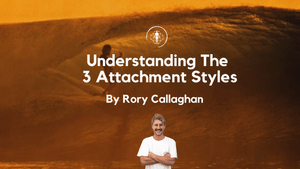Are Your Relationship Patterns Keeping You Disconnected?
Have you ever wondered why some relationships feel so effortless while others seem like constant work? Why certain people trigger intense emotions in you, while others feel safe from day one?
I spent years feeling disconnected in relationships, alternating between clingy desperation and cold detachment. It wasn't until I understood attachment styles that I realized these weren't personality flaws – they were adaptive strategies I'd developed early in life. This revelation transformed how I connect with others and forms a cornerstone of what I share in my SelfCare Book.
The 3 Major Challenges We're Here to Solve Together
- Repeated Relationship Patterns: Breaking free from the unconscious attachment cycles keeping you disconnected from authentic connection.
- Emotional Reactivity: Understanding your emotional triggers and learning to respond rather than react when attachment wounds are activated.
- Self-Abandonment: Discovering how to stay connected to yourself while connecting deeply with others.
Would you be curious to learn how others are transforming their relationship patterns? Our SelfCare Community is full of people on the same journey, sharing their experiences and supporting each other through this process of rediscovering authentic connection.
The SelfCare Framework: Learn-Do-Embody-Teach
Our approach to healing attachment wounds follows a progressive path that transforms intellectual understanding into embodied wisdom:
1. LEARN: Recognize Your Attachment Blueprint
Understanding your attachment style isn't just academic—it's the foundation for transforming your relationships. Research shows that most people are entirely unaware of how their early experiences shaped their ability to connect. Your "attachment blueprint" operates below conscious awareness, influencing everything from your partner selection to how you respond to conflict.
The journey begins with honest self-reflection: Are you a wave, constantly seeking reassurance? An island, maintaining emotional distance? Or perhaps you've found secure ground as an anchor? This awareness isn't about self-judgment but self-understanding—seeing how your past adaptations may be limiting your present connections.
2. DO: Practice New Connection Patterns
Knowledge without action creates interesting conversations but not transformation. Once you understand your attachment patterns, it's time to practice new ways of connecting—starting with small, consistent steps that gradually rewire your neural pathways.
For waves, this means practicing self-soothing before reaching for reassurance. For islands, it's allowing small vulnerabilities with safe people. Each practice creates a 1% improvement that compounds over time. The key is consistency, not perfection. When you stumble back into old patterns (and you will), simply notice, reset, and begin again. This is precisely how new neural pathways form.
3. EMBODY: Become Securely Attached
Embodiment happens when secure attachment shifts from something you practice to someone you are. Your nervous system recalibrates, creating a new baseline of safe connection. You'll notice subtle but profound changes—less reactivity during conflict, greater ease with both intimacy and independence, and a deepening trust in yourself and others.
This doesn't mean perfect relationships. Rather, it means you can navigate relational challenges without activating survival responses. You stay present rather than disappearing into anxiety or avoidance. When triggers arise, you recognize them as old patterns rather than current reality. This is the essence of secure attachment—not absence of challenge but resilience through challenge.
4. TEACH: Share Your Healing Journey
The final stage of transformation comes when your personal healing creates ripples of change around you. This isn't about formal teaching but authentic sharing—allowing your journey to inspire others while creating communities where secure attachment can flourish.
Teaching might look like mindfully parenting to create secure attachment for the next generation. It might mean mentoring someone earlier in their healing journey. Or it could simply be modeling healthy boundaries and authentic vulnerability in your everyday interactions. However it manifests, this stage transforms personal healing into collective wellbeing—creating the connected world we all deeply desire.
The Science of Connection: Anchors, Waves, and Islands
Attachment theory isn't just theoretical psychology – it's the science of how we connect. Research consistently shows that our early caregiving experiences create neural pathways that influence our relationships throughout life.
Imagine relationships as an ocean, and people as three distinct types:
Anchors (Secure Attachment): These fortunate few (about 50% of people) received consistent, attuned care early in life. They're comfortable with intimacy and independence, trust others easily, and recover well from relationship conflicts. Their inner mantra is: "I am worthy of love and capable of giving it freely."
Would you be open to considering which attachment style resonates most with your experience? Let's explore the other two:
Waves (Anxious Attachment): Always moving toward shore, waves (about 20% of people) fear abandonment and seek constant reassurance. They're hypervigilant to rejection cues and often feel "too much" in relationships. Their nervous systems are calibrated for connection at all costs.
Islands (Avoidant Attachment): Standing alone and self-sufficient, islands (about 25% of people) minimize their need for connection. They value independence and often feel suffocated by others' emotional needs. Their nervous systems are calibrated for self-reliance and emotional distance.
Many of us (about 5%) are Fearful-Avoidant – both wave and island simultaneously, creating a painful push-pull dynamic in relationships.
What these patterns share is disconnection – from others, from ourselves, or both. When we're operating from insecure attachment, we're not truly present. We're trapped in survival responses that might have protected us as children but now keep us from the connection we deeply desire.
This is precisely why understanding your attachment style is transformative. It moves you from unconscious reactivity to conscious response. From passenger to driver of your relationship experiences.
The Three Paths to Secure Attachment
The remarkable truth about attachment is that it can change throughout life. Neuroplasticity – your brain's ability to form new neural pathways – means you're not stuck with your childhood attachment pattern.
Here are three evidence-based paths to developing secure attachment:
1. Earned Security Through Relationships
When you experience consistent, attuned care from a partner, therapist, or close friend over time, your brain literally rewires. This is why the SelfCare Community creates such profound transformation – it provides a secure base from which to explore new ways of connecting.
2. Metacognitive Monitoring
This fancy term simply means becoming aware of your attachment patterns as they happen. When you notice yourself acting like a wave (anxiously pursuing) or an island (coldly distancing), you create space to choose a different response.
Research shows that simply understanding your attachment style can dramatically improve relationship satisfaction. This awareness is a core focus in my SelfCare Book, where I guide readers through recognizing their patterns.
3. Somatic Repatterning
Your attachment style lives in your body as much as your mind. Through practices like breathwork, movement, and mindfulness, you can calm your nervous system's threat response and create the physiological safety needed for secure connection.
May I ask – which of these paths resonates most with you right now?
Becoming an Anchor: Your Path to Secure Connection
The journey to secure attachment isn't about perfection – it's about progression. Each small step creates new neural pathways that, over time, become your default way of being.
Here's what that journey might look like:
For Waves (Anxious Attachment):
- Practice self-soothing when separation anxiety arises
- Build identity and interests outside of relationships
- Learn to recognize and communicate needs clearly
- Cultivate trust in your inherent worthiness
For Islands (Avoidant Attachment):
- Practice staying present with emotional discomfort
- Share vulnerabilities in small, manageable doses
- Notice and challenge beliefs about self-sufficiency
- Develop comfort with healthy dependence
For Fearful-Avoidants:
- Create safety through consistency and boundaries
- Work with trained professionals to process trauma
- Practice both self-soothing and vulnerability
- Build relationship skills gradually with safe people
Remember: Healing happens in connection, not isolation. This is why community support accelerates transformation – we quite literally borrow each other's regulated nervous systems until our own recalibrate.
What if I told you that within 12 months of focused practice, you could fundamentally change your attachment orientation? The research supports this possibility, especially when combining self-awareness, intentional practice, and supportive relationships.
Your Next Step: From Disconnection to True Connection
Disconnection in relationships isn't your fault, but healing is your responsibility. Your attachment style developed as a brilliant adaptation to your early environment – it helped you survive. Now it's time for new adaptations that help you thrive.
Would you be open to taking one small step today? Perhaps:
- Reflecting on which attachment style feels most familiar
- Noticing one recurring pattern in your relationships
- Practicing a moment of connection with yourself through breath
For deeper exploration of how attachment influences your wellbeing, the SelfCare Book offers a comprehensive guide to understanding and transforming your relationship patterns.
And if you're ready to experience the healing power of secure attachment in community, I'd love to welcome you into our SelfCare Community where we practice these principles together.
Remember: Your capacity for secure connection isn't determined by your past. It's created by your present choices and future vision.
Key Research References:
- Mikulincer, M., & Shaver, P. R. (2021). Attachment theory and emotions in close relationships: Implications for relationship functioning and therapy. Emotion Review, 13(3), 223-237.
- Levine, A., & Heller, R. (2012). Attached: The New Science of Adult Attachment and How It Can Help You Find—and Keep—Love. Penguin.
- Siegel, D. J., & Bryson, T. P. (2020). The Power of Showing Up: How Parental Presence Shapes Who Our Kids Become and How Their Brains Get Wired. Ballantine Books.
REFERENCES
This is directly referenced from the Amazon best-selling SelfCare Book "Lifestyle Medicine For the People" by Rory Callaghan. If you would like to read more content like this, grab the free online chapters of the book or a hard copy.
We have done our best to reference everyone's expert opinions, peer-reviewed science, and original thoughts, all references available here and referenced in the text.
We also understand that most thoughts are not our own and there is a collective unconsciousness, unconsciousness, and universal mind stream of energy that is always at work. How our references are sorted and filtered is here.
This article is for informational purposes only and should not replace professional medical advice. Always consult with your healthcare provider before beginning any new health regimen.





